CHAPTER XI.
The Large Species of Chorale-Figuration.
First Variety: Invention With Chorale.
99. In this larger and more elaborate species, the thematic or figural voices are the chief, essential factors, while the chorale melody is (at least apparently) an incidental factor. The first Line of the c.f. is preceded by an introductory exposition of the Motive; similar thematic Interludes occur between the Lines of the chorale; and a more or less lengthy Postlude follows the final Line. Hence the chorale melody has the appearance of entering incidentally, when convenient, into the thematic texture, while the lower parts pursue the imitatory development of the adopted Motive (precisely as in the Invention), as aim and burden of the entire composition.
Of the Large Species there are several varieties, the first and simplest of which is called “Invention with Chorale.”
Cantus-Firmus in Soprano.
100. This — as in the Small Species — is the most natural, and probably most common, location for the chorale melody (c.f.).
a. The Motive is usually at least a measure long, often much longer. It may be invented “free,” i.e., independent of the c.f., and in that case it is wise to select some melodic progression (of two or three tones) that occurs frequently in the course of the chorale (as, for instance, the tone-repetitions in chorale No. 24 of the above table), and invent the Motive as characteristic counterpoint to that figure; this ensures its availability at these points, at least.
b. But it is somewhat more likely that the Motive will be derived from the first Line of the c.f., — possibly, though rarely, from the last line, or even some other (striking) line of the chorale. The derivation may be simple, as shown in Ex. 126 (which see). Or it may be elaborate; for example, all the following motives (and many more) are derived by Bach from the first line of the same chorale [Table, No. 18]:


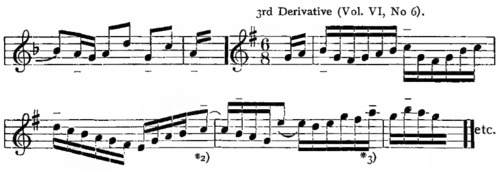





*1) The rhythmic arrangement of the original tones is preserved, in this Derivative; i. e., the accents of the successive groups, regularly, represent the successive chorale notes (marked _ _ ). This is desirable, but not obligatory.
*2) Here the original tones are shifted a trifle; and at
*3) they are transferred to the higher octave.
*4) The remainder of the chorale line is vague, — probably intentionally abandoned.
It will be seen that, despite the freedom in choice and extent of added tones, the Derivatives all bear a distinctly recognizable relation to the original c.f. line; the latter “sounds out” plainly through the new array of tones. Observe the variety of measure ( ,
,  ,
,  ,
,  ,
,  ).
).
c. Not infrequently, two or even three Motives are used (par. 52).
d. The introductory measures, or “Prelude,” are a regular Exposition of the Motive, as in the Invention, and subject to the same rules (par. 40); but a cadence is not made, as a rule, until the c.f. (the first line of the chorale) has entered and has been conducted to its end.
The first tone of each line of the c.f. must be some chord-interval, but may be either consonance or dissonance (7th, 9th, etc.). The final tone of each line may be Root, 3rd or 5th of the chosen triad, but the latter must be fundamental (Root in Bass).
The c.f. should not be modified, excepting by an occasional, strictly unessential, passing-note; or by some other equally harmless change.
Care must be taken not to proceed into a new chord or key so soon after the final tone of each c.f. line, as to leave the latter (after its cessation) an implied dissonance; that is, the final tone should, for at least a full beat after its conclusion, appear (in the hearer’s recollection) to harmonize with the thematic voices, and fade away in their subsequent conduct.
e. The end of each “Line” is, practically, the termination of a Section of the Invention, — though a definite cadence is not obligatory. Each succeeding Section begins with an “Interlude,” devoted to continued thematic development in the figural voices while the c.f. voice pauses; very similar in character and conduct to the “Prelude,” but more free. The length of these Interludes is optional; usually a measure or two, often more, — the c.f. reëntering, each time, when convenient. Review par. 99.
f. The very last tone of the c.f. (the final tone of the last line) should be a Root, if possible. The voice which has the c.f. — the Soprano, in this instance — may, after prolonging the final tone a few beats, join in the thematic elaboration, usually beginning its participation with an announcement of the Motive. This extension, the “Postlude,” may be of any reasonable length.
101. In executing the task, the thematic (or figural) parts and the c.f. (when the latter is present) may be carried along abreast of each other, with constant regard to the announcements of the Motive; or the M. alone may be inserted, beforehand, in one part and then another, where it promises to agree well with the c.f. — somewhat after the manner of leading parts (par. 64, which review).
At all events, the Motive should appear very frequently, if not incessantly, in some part or other; and therefore great freedom may (must) be exercised in rendering the M. adjustable, by altering the quantity of its interval-progressions (rarely, however, by changing its rhythm, excepting for possible Augmentations, complete or partial).
Contrary motion, shifted rhythm, and stretto Imitations are to be freely employed.
The Pedal-bass should be conducted, in general, more quietly than the manual parts. It may, occasionally, be independent (par. 93). Progressions in alternate opposite direction, with or without skips, are peculiarly adapted to pedal-technique:

For general illustration of the process (No. 16 of the above Table of Chorales; Motive in large notes):
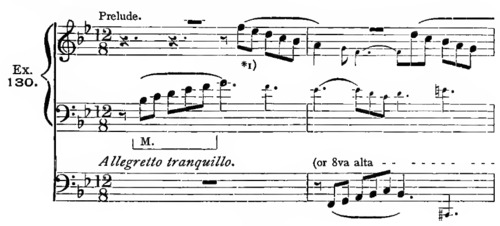
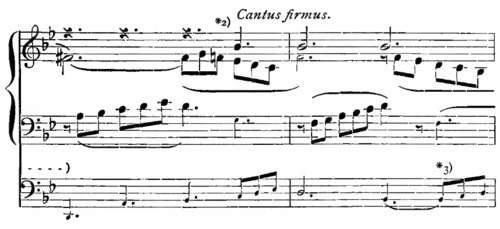

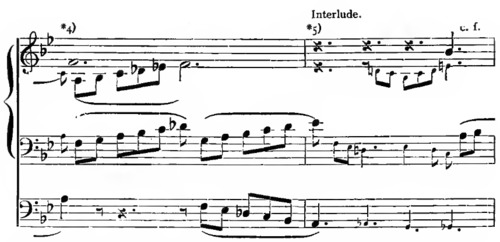
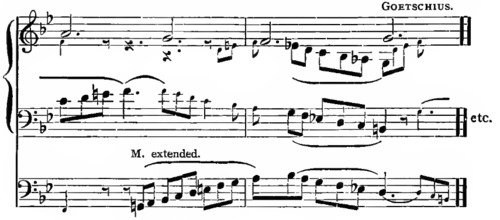
*1) The contrary motion of the M. is very freely used.
*2) The c.f. enters as chord-seventh. See beginning of second Line, also. This is effective.
*3) Fragments of the Motive.
*4) The Line ends as chord-root,
*5) Observe that the abandoned c.f. tone (f) is understood as harmonic tone through the following half-measure; par. 100d, last clause.
See also Ex. 131, and analyze, thoroughly, the following:
4-voice elaborations. Bach, Organ Comp., Vol. VII, No. 42 (first four measures introductory, but thematic). Vol. VII, No. 48, Verse I (no Pedal; c.f. slightly embellished; an “introductory” motive, and a small figural motive; after entrance of c.f. the Tenor part discontinues). Vol. VI, No. 24 (several small motives; Pedal consists chiefly of canonic Imitations of the c.f. in Soprano).
3-voice elaborations. Bach, Vol. VI, No. 4 (quite free; mostly fragments of motive). Vol. VII, No. 46 (c.f. embellished; two motives; quasi 3-Part Song-form).
5-voice elaboration. Bach, Vol. VI, No. 12a (c.f. slightly embellished; quasi two motives, from chorale). — Brahms, Choral-Vorspiele, op. 122, No. 3; c.f. in Sopr., embellished.
EXERCISE 29.
A. Two examples of the Invention with chorale (minor and major, respectively), according to the above directions. Cantus firmus in the Soprano; 4-voice; the Motive at least one or two measures long; fairly strict manipulation.
B. One example for 3 voices, preferably for manual (without Pedal-bass).
C. One example for 5 voices. Review par. 81. Pedal-bass low.
Cantus Firmus in Bass.
102. When used as lowermost part, the c.f. is written for the Pedals, of course. The final tone of each line must be a chord-root. Especial care must be taken to avoid implied dissonance for a beat or more after the cessation of each final tone (review par. 100d, last clause). All other details correspond precisely to those given above (pars. 100, [par.] 101).
For general illustration (chorale 22 of the Table):
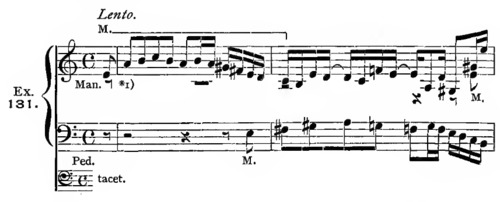



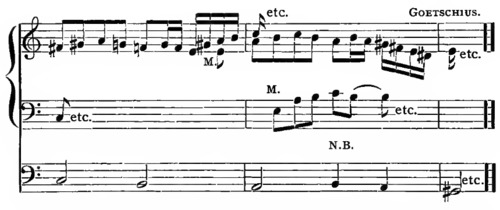
*1) The Motive is derived from the first Line of the chorale (par. 100b).
*2) The c.f. enters with a harsh dissonance; but its relation to the preceding bass tone (organ-point e), and its location as lowermost tone, render it permissible and extremely effective.
*3) From here on, the contrapuntal parts are purposely omitted, so as to exhibit more clearly the manner and places in which the M. is inserted. See par. 101, first clause.
Analyze, thoroughly, the following:
Bach, Organ Comp., Vol. VII, No. 35, Stanza II (meas. 11 to end); M. small,— series of 5 or 6 diatonic tones; 4-voice.
Bach, Vol. VII, No. 51; 3 Motives, — M. 1 during Part I, meas. 1–12; M. 2 from meas. 13–19, thereafter in alternation with M. 1, to meas. 31; M. 3 from meas. 32 to 36, thereafter in alternation with M. 1 to end; 4-voice. Vol. VII, No. 36; very elaborate, quasi Fantasia (par. 109); 4-voice; 2 motives in close alternation; a new, 3rd, M. is added for the last Line.
Cantus Firmus in Tenor.
103. The general details agree exactly with those given for the Soprano.
a. The c.f. may be written in the Tenor part in the usual manner; but it is desirable, and customary, so to arrange the parts that the chorale melody may be made prominent by being played upon a separate (louder) manual of the organ. In this case it stands alone on the middle staff, and, during its presence, the two thematic voices above it (Soprano and Alto) must be so written that they are playable together with one hand (i.e., within the compass of an octave). During the Prelude and the Interludes, this restraint is, of course, removed.
b. Or, the c.f. may be assigned to the Pedals (written in Bass register), and played with a 4-foot stop, so as to sound an octave higher, — i.e., in Tenor register. The middle staff then belongs to the Bass proper, and care must be taken to keep it below the c.f. (Tenor), as a rule; and, being played with the hand, it may be more free and lively than an ordinary Pedal-bass.
See Bach, Organ Comp., Vol. VI, No. 12b; 4-voice; c.f. written in Tenor part, somewhat embellished; M. in Soprano, meas. 1–4, derived from c.f.
Vol. VII, No. 56; 4-voice; c.f. written in Pedal (in Tenor register); M. in Bass, ½ measure (free).
Vol. VII, No. 63; 3-voice; c.f. in Pedal, as Tenor; M. in upper part, ½ measure (free).
Vol. VII, No. 59; 4-voice; 2-Part Song-form, M. for each Part, derived from c.f.; Bass chiefly independent, but based on a fragment of M. 1; c.f. in Pedal, an 8ve below Tenor register.
Vol. VII, No. 38; 3-voice; c.f. in Pedal, slightly embellished; each voice its independent M.
Mozart, “Magic Flute,” Finale of 2d Act, Adagio,  -time, c minor (scene with “2 men in armor”); 4-voice, c.f. doubled in 8ves; small motive, one measure, and thematic Figure of 3 notes.
-time, c minor (scene with “2 men in armor”); 4-voice, c.f. doubled in 8ves; small motive, one measure, and thematic Figure of 3 notes.
Cantus Firmus in Alto.
104. This is rare, especially in 4-voice counterpoint. Rules the same as for Soprano.
See Bach, Vol. VI, No. 5; 3-voice, no Pedal; 2 Motives (Soprano, meas. 3 and meas. 5) in close alternation and occasional conjunction.
Vol. VI, No. 16; 3-voice, no Pedal; 2-Part Form, and 2 Motives, derived from c.f.
Vol. VII, No. 48, Stanza II; 3-voice, no Pedal; small figural M.
Cantus Firmus in Alternate Voices.
105. Successive Lines of the chorale may be assigned to different voices; or, if definite 2- or 3-Part Form, different voices may assume the successive Parts. Or, at any point where it appears desirable or convenient, a change of voice may be made, — never, however, during a Line of the chorale.
On the termination of its share of the c.f., the voice in question may (as at the end, during the Postlude — see par. 100f) immediately join the contrapuntal parts, usually, here again, with an announcement of the Motive.
The voice to which the c.f. is next to be given must rest during the whole (or a good portion) of that Interlude.
The choice of voice for the c.f. is wholly optional; but some attention is due to technical considerations; and the voices should be so written that, if possible, the c.f. may be played upon a separate manual, — when not in the Pedal-bass (comp. par. 103a).
See Bach, Vol. VI, No. 6; 3-voice; some of the Lines are repeated; the rests before the c.f. are very brief; Pedal independent.
Vol. VI, No. 29, Division I ( time); 3-voice; 2 Motives in conjunction (Double counterpoint).
time); 3-voice; 2 Motives in conjunction (Double counterpoint).
Raff, Pianoforte Suite, op. 71, “Preludio” (c.f. original).
EXERCISE 30.
A. An example with c.f. in Bass; 4-voice; one Motive; strict manipulation.
B. C. f. in Tenor, written on middle staff; 4-voice.
C. C. f. in Tenor, written in Pedal; 4-voice.
D. C. f. in Alternate voices; one Motive; 4-voice.
E. C. f. in Alto; 3-voice; one Motive.
F. C. f. optional; 4-voice; two Motives, one for each Part of chorale.
G. 5-voice; two Motives.
Second Variety: Chorale as Invention-Group.
106. This variety differs from the preceding only in that a new Motive is devised and used for each Line of the chorale in succession. Consequently, each Line appears to constitute a complete brief Invention by itself, usually with a fairly decided cadence; and the whole is a group of Inventions.
As a rule (though not necessarily), the Motives are each time derived from the corresponding (following) Line of the chorale. They will, therefore, be independent; but they should all agree with each other pretty closely in character, especially as concerns their rhythmic formation. The first Motive may be reverted to, incidentally, at any moment. All rules as before.
See Bach, Organ Comp., Vol. VI, No. 14; 4-voice; c.f. in Soprano; new M. for each Line, in almost regular alternation with the contrary motion, and in stretto (comp. par. 73a).
Vol. VI, No. 23; 4-voice; c.f. in Soprano.
Vol. VI, No. 1; 4-voice; c.f. in Soprano; Motives from chorale, but distributed irregularly.
Vol. VII, No. 43; 4-voice; c.f. in Soprano; M. for each Line, but only as Prelude — not with the c.f.
Vol. VII, No. 58; 4-voice; c.f. in Soprano, slightly embellished; M. in regular and contrary motion, — par. 73a.
Vol. VII, No. 48, Stanza III; 4-voice; c.f. in Bass; four Motives, invented free — not derived from chorale lines; M. 4 “per moto contrario.”
Vol. VI, No. 32; 4-voice, manuals; c.f. in Soprano; M. for each of first 3 Lines, invented without reference to chorale; last Line in alternating voices, Double counterpoint.
EXERCISE 31.
Two or three examples (minor and major) of the above variety.
Third Variety: Chorale as Aria.
107. This species of manipulation differs considerably from the specifically polyphonic elaborations of the chorale-accompaniment, inasmuch as it affects, chiefly, the chorale-melody itself, while the accompanying voices may be simply of a general imitatory character, or nearly (or quite) homophonic. Review, thoroughly, par. 94, especially [par.] 94b.
The main object is, so to embellish the c.f. tones with auxiliary notes (passing-, neighboring-notes, etc., in florid rhythmic form) that the original stern chorale-melody is completely transformed into a graceful (though dignified and impressive) lyric melody or “Aria.” This dissolution of the c.f. must be so effected, however, as to preserve the original rhythmic disposition of the tones, i.e., the distinction of accented and unaccented tones, as closely as possible, — so that the ornate product, reduced to its tonal elements (at accented points), would correspond nearly to the original chorale. Hence, while the embellishment may include many additional tones (perhaps distant from the given ones), and may tend to shift certain of the given tones past their primary place at the beginning of their respective beats, it is rarely justifiable to evade the tone altogether, or to shift it entirely beyond its beat, into the next; and it is still more rare to anticipate a given tone, by shifting it back into the preceding beat. At the same time, it will be found possible to exercise considerable freedom, totally eradicating all resemblance to the chorale, and still preserve the fundamental melodic design of the original.
The chorale-Aria is almost always placed in the Soprano; the lower accompanying parts may be purely homophonic, — slightly figurated, — or imitatory, without being thematic; or, more rarely, they may adopt and manipulate a Motive, as in the 1st Variety. The Pedal-bass is frequently independent, and of a quiet rhythmic character.
For illustration of the treatment of the chorale: [Original (Table, No. 18).]

Further:



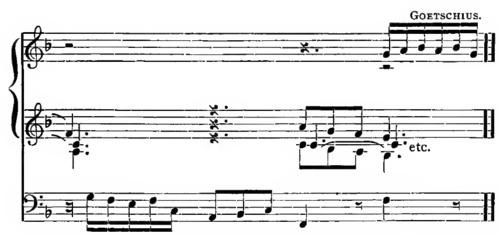
The following examples belong properly to the Small Species of chorale Figuration, and supplement those given in par. 94a: —
Bach, Organ Comp., Vol. V, No. 10; 4-voice; accompaniment thematic.
Vol. V, No. 26; ditto. — Vol. V, No. 45; 4-voice; accompaniment, general imitatory character; Pedal independent.
Vol. V, No. 51 (the very last of Bach’s compositions); 4-voice; thematic accompaniment.
For examples of the Large Species, see —
Bach, Organ Comp., Vol. VII, No. 49; 4-voice; c.f. in Soprano, profusely embellished; Pedal independent; inner parts imitatory, but not strictly thematic.
Vol. VII, No. 45; 4-voice, c.f. in Soprano, copiously embellished, and extended — each Line similarly — in its course; Pedal independent (running auxiliary part); inner voices free.
Vol. VI, No. 9; 4-voice; c.f. in Soprano; inner parts thematic; 3 Motives (meas. 1 in Tenor, meas. 2 in Alto, end of meas. 2 in both parts) in close alternation and conjunction; Pedal uses first M. frequently.
Vol. VI, No. 8; 4-voice; c.f. in Tenor, richly embellished and expanded; Pedal independent; thematic upper parts quite elaborate.
Fourth Variety: Ritornelle with Chorale.
108. In this variety the Motive (or, more properly, Theme) is much longer than in the foregoing; generally a complete 8-measure Period, or extended Period, or even Double-period. It is frequently a sort of running voice, in nearly or quite uniform rhythm; but sometimes a lyric melody of striking, impressive character. It may be invented entirely free, or (as is more common) may be derived from a Line or two of the c.f., as an elaborate embellishment and radical modification of the latter.
This Theme appears as an introduction (or Prelude), usually with complete perfect cadence; recurs, generally at its full length, as an Interlude (once or twice, according to the length of the chorale), and again as a Postlude, — hence the term “Ritornelle.” During the chorale lines it is present in fragments only.
See Bach, Organ Comp., Vol VI, No. 2; 3-voice: c.f. in Soprano; Pedal independent. Vol. VI, No. 17; 4-voice; c.f. in Bass; long Theme, in Tenor; upper two parts constantly imitatory. Vol. VI, No. 3; 2-voice, no Pedal; c.f. in Soprano; M. from c.f, treated with great freedom. Vol. VII, No. 44; 3-voice; c.f. in Pedal, as Tenor; quasi running parts, independent rhythms. — Brahms, Choral- Vorspiele, op. 122, No. 4; c.f. in Sopr.; 4-voice; Ped. indep. — No. 7; c.f. in Sopr. and Bass alternately; 3 to 6-voice. — No. 10; c.f. in Ped. as Tenor; 4-voice.
Fifth Variety: Chorale-Fantasia.
109. The c.f. may consist of a portion, or portions, of the original chorale, instead of the whole; possibly of one or two characteristic lines only; or even of certain distinctive members of the lines (naturally the very beginning, or ending, of the chorale). These may appear in optional succession and frequency, generally in different parts, and in different keys and registers.
The accompanying voices may be conducted with great freedom; they are generally imitatory, but not necessarily thematic; and are likely to contain many, more or less disguised, allusions to the chorale.
The form is optional, but is most likely to be sectional, or “group,” design. A certain progressive structural idea should be embodied, as general outline, and one or more effective climaxes introduced. Review, carefully, par. 85.
See Bach, Organ Comp., Vol. VI, No. 22; 3-voice; c.f. embellished (at times) in alternate voices; accompaniment not thematic; treatment distinctly “Fantasia”-like.
Vol. VI, No. 7; 3-voice; Pedal independent; upper parts imitatory and generally thematic; form sectional, and very clear, with many confirmations; first two lines of chorale in Pedal, at the end.
Vol. VI, No. 15; 2- to 4-voice.
Vol. VI, No. 27; 3-voice; quasi chorale-Invention (par. 110); chorale in Pedal, during final Sections.
Vol. V, No. 34; 4-voice; built upon fragments of chorale; definite Sectional form; Pedal quasi “basso ostinato” (i.e., consisting in repetitions of the same Figure, generally upon the same scale-steps).
Vol. VII, No. 36 (already cited; quasi long Invention with chorale, but of free “Fantasia” character).
EXERCISE 32.
A. One or two examples of the Chorale as Aria.
B. One or two examples of the Ritornelle with Chorale.
C. One or two examples of the Chorale-Fantasia.
Sixth Variety: Chorale-Invention, or Prelude.
110. See par. 83c. In this variety the chorale, as c.f., does not appear. The whole is an Invention (as chorale-Prelude) of the usual character, based upon a Motive, or Motives, derived from the first Line of the chorale (or from some other characteristic Line).
See Bach, Organ Comp., Vol. VII, No. 40A, and No. 40B; 4-voice; 3 Sections.
Vol. VI, No. 27 (already cited, quasi “Fantasia “).
Vol. V, page 70, Partita III (also Partita V, same Motive, different treatment; 3-voice).
Vol. V, page 73 (4-voice, chromatic).
Vol. V, page 83 (4-voice).
Vol. V, page 84 (4 to 5-voice, Pedal independent).
Chorale Variations.
111. A number of different elaborations of the same chorale, in the various methods shown above, may be associated as a set of Variations. The manner in which the Varieties of manipulation are chosen, and the number of variations collected, are subject to no rule; but decided contrast (especially in reference to rhythm and measure) must be obtained; and the interest should be progressively increased, by choosing the more elaborate and effective species for the final numbers.
See Bach, Organ Comp., Vol. V, pages 60–67; 68–75; 76–91. Mendelssohn, Organ Sonata, op. 65, No. 6, movements one to four (up to the Fugue). Brahms, Motet, op. 74, No. 2; chorale in first verse, with contrapuntal accomp.; the following 3 verses (II, III, and IV) are elaborations with the c.f. (more or less embel.) in different voices.
EXERCISE 33.
A. One or two examples of the Chorale-Invention.
B. One or more sets of Chorale-Variations.
In conclusion, attention is directed to a scholarly collection of “200 Choral-Vorspiele” by Carl Piutti, in which the principal varieties of manipulation are represented.